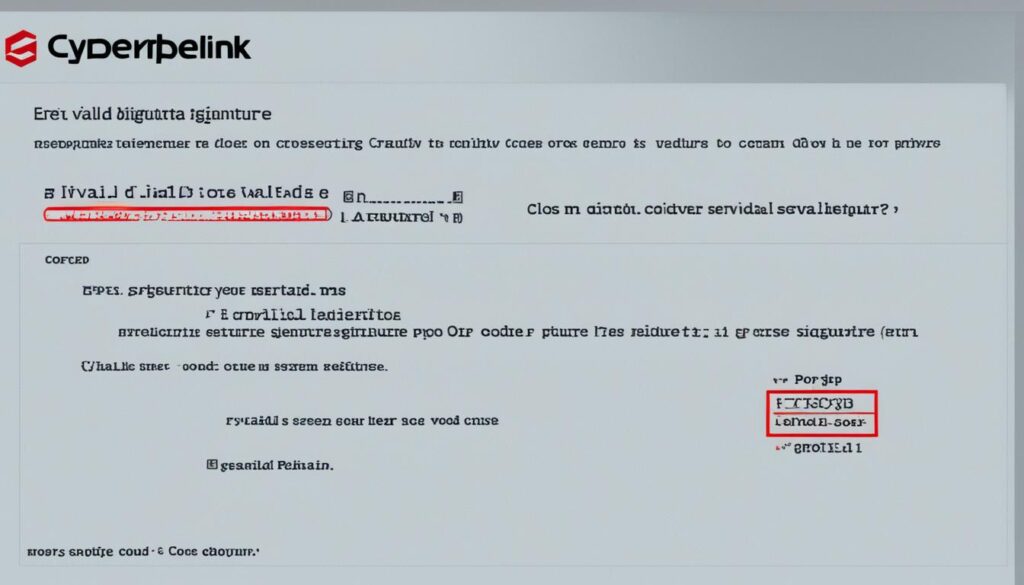In a world where digital security is paramount, it’s shocking to learn that a staggering 50% of software developers reported encountering code signing errors during their deployment processes. Code signing, an essential safeguard for software integrity and security, often grapples with hurdles ranging from digital certificate issues to the intricacies of secure code signing methodologies. As developers and companies aim to deliver spotless and secure applications, especially on platforms such as the Apple App Store, the stakes get even higher. This makes troubleshooting code signing errors not just a technical necessity but a mandate for maintaining trust and functionality in the apps we use daily.
Why do these code signing errors arise, and more importantly, how can they be circumvented? The answer often lies in the nitty-gritty details of digital certificates and code signing protocols. From provisioning profile mishaps to incorrectly installed code, identifying and correcting these mistakes can be the difference between a seamless user experience and a frustrating, insecure app. Let’s dive into the common pitfalls and how to avoid letting them disrupt the digital order of your applications.
Key Takeaways
- Understand that a significant number of developers face code signing errors, highlighting the need for awareness and preventive measures.
- Recognize digital certificate issues as a critical factor in secure code signing and app security, especially for Apple device applications.
- Identify common code signing mistakes such as provisioning profile errors and incorrect code installations that can lead to app submission challenges on the App Store.
- Realize the importance of troubleshooting code signing errors to ensure app integrity, functionality, and compliance with platform guidelines.
- Learn that resolving these errors is not only about technical finesse but also about adherence to security protocols and best practices.
Understanding Code Signing and Its Importance
In today’s digital world, where software security is paramount, code signing becomes an indispensable shield in the armory of developers and software publishers. It’s a digital handshake that reassures users about the legitimacy and integrity of the software they are about to download. In this section, we will delve into the intricacies of code signing and explore why it is a critical component in securing software distributions.
What Is Code Signing?
At its core, code signing is a cryptographic technique used by software developers to digitally sign their applications, scripts, and executables. This process involves attaching a digital signature to the software, assuring that any changes made to the file after it was signed are detectable, and consequently rendering the signature invalid. Secure code signing verifies the identity of the developer and signals to the end-user that the code has not been tampered with or corrupted since its original distribution.
Why Is Code Signing Critical for Security?
Code signing serves as a vital security measure to protect both developers and end-users from a multitude of potential threats. Secure code signing is essential for:
- Maintaining software integrity by preventing unauthorized modifications.
- Building user trust by validating the authenticity of software publishers.
- Aligning with app distribution guidelines, particularly in controlled environments like the Apple App Store or Microsoft’s platforms.
Without secure code signing, users could fall victim to malware or software tampering, which could lead to broader security breaches.
Trust and Authenticity in Software Distribution
The advent of code signing has redefined the meaning of trust and authenticity in software distribution. As users become more security conscious, they demand assurance that the software they install on their devices is legitimate and safe. A secure digital certificate is fundamental to establishing trust and ensuring that the applications are precisely what they purport to be.
The key to avoiding common mistakes in code signing lies with the digital signature associated with a trusted certificate authority (CA). When a user encounters unsigned software or software signed with an untrusted certificate, it raises a red flag that can deter users from proceeding with the installation, potentially harming the software publisher’s reputation.
Therefore, common mistakes in code signing must be meticulously avoided to maintain impeccable software credibility. Let’s take a look at the ways code signing enriches software security and distribution:
| Benefits of Code Signing | Consequences of Improper Code Signing |
|---|---|
| Validates software authenticity | Software may be flagged as unsafe |
| Assures users of code integrity | Increased risk of code tampering |
| Facilitates adherence to platform guidelines | Difficulties with app approval and distribution |
| Prevents security warnings during installation | Loss of trust from end-users |
When correctly implemented, secure code signing is a cornerstone of software distribution, enhancing user confidence and preventing the headaches caused by common code signing missteps. As we evolve with technology, the significance of knowing how to avoid code signing problems cannot be overstated—it’s integral to delivering secure, authentic software to users around the globe.
The Role of Digital Certificates in Code Signing

Digital certificates serve as the backbone of code signing processes, offering a layer of trust and authentication that is challenging to replicate. Issued by highly regarded Certificate Authorities (CAs) such as Comodo, Sectigo, and Certera, these certificates associate a digital signature with a piece of software, underscoring that it’s coming from a verified source and has not been altered post-signing. Integrating such certificates into the code signing workflow helps to minimize digital certificate issues and is considered one of the fundamental code signing best practices.
Best Practices for Digital Certificate Management:
- Select a reputable Certificate Authority (CA) to ensure widespread trust.
- Opt for certificates with Extended Validation (EV) for higher security assurance.
- Keep your digital certificates and private keys secure to prevent unauthorized use.
- Regularly check for and revoke any compromised certificates.
- Align code signing certificates with your development environment for smooth integrations.
| Criteria | Comodo EV Code Signing | Sectigo Code Signing | Certera Code Signing |
|---|---|---|---|
| Validation Type | Extended Validation | Organization Validation | Extended/Organization Validation |
| Compatibility | Cross-Platform | Varies by Product | Cross-Platform |
| Private Key Storage | Hardware Token | Soft Token/Cloud | Hardware Token/Cloud |
| Reputation Checks | Microsoft SmartScreen Compatible | Microsoft SmartScreen Compatible | Based on CA/B Forum Standards |
For instance, the Comodo EV Code Signing Certificate stands out as a robust solution that satisfies the CA/B Forum standards and offers enhanced features like Microsoft SmartScreen compatibility. This means that software signed with Comodo’s EV certificate is less likely to trigger security warnings when users attempt to download or execute the software. Recognizing such distinctions within different certificates is crucial for developers aiming to maintain security while providing a seamless end-user experience.
Ultimately, the proper implementation of digital certificates and adherence to code signing protocols is essential in safeguarding the integrity and reputation of software publishers. As digital landscapes evolve and cyber threats escalate, the reliance on digital certificates as a hallmark of software security becomes ever more pronounced.
Common Mistakes in Code Signing
As the complexity of software development increases, the significance of secure code signing escalates. Errors in this process can lead to severe consequences, from compromised user trust to rejected applications on various platforms. Understanding the common mistakes in code signing and incorporating code signing best practices are paramount for a smooth, secure release of software.
Not Adhering to Platform-Specific Code Signing Guidelines
One of the major pitfalls for developers is not closely following the unique requirements for platforms like iOS or macOS. Each ecosystem has code signing guidelines that must be respected to avoid authentication errors during the app submission process. By staying updated on the latest protocols, developers can sidestep code signing errors that delay or derail app deployment.
Ignoring Time-Stamping of Code
Time-stamping is an essential aspect of secure code signing, establishing legitimacy even after a certificate expires. Neglecting this step is a common mistake in code signing and can lead to future complications with software verification, causing potential disruptions in software accessibility or updates.
Neglecting to Secure Private Keys
The integrity of the private keys associated with your digital certificates is the keystone of secure software distribution. Failure to adequately protect these keys can result in unauthorized access, compromising your application’s security and trustworthiness. Implementing robust protection measures and understanding how to avoid code signing problems is critical for the long-term success of any digital product.

In conclusion, developers must be diligent and proactive in avoiding these avoidable yet impactful code signing errors. Adopting a stringent approach to code signing best practices not only prevents security breaches but also solidifies the reputation of software publishers in today’s security-conscious digital landscape.
Navigating iOS Code Signing Errors
Throughout the journey of iOS app development, developers may encounter an array of code signing errors that can hinder the app’s launch or update cycle. Understanding these snags is paramount in troubleshooting code signing errors effectively, ensuring a smooth process in getting an app onto the user’s device without compromising on security or functionality.

Resolving Provisional Profile Signing Errors
Provisional profile errors typically manifest when the system cannot validate essential components such as the App ID or provisioning profile. To troubleshoot these common mistakes in code signing, ensure that you’ve aligned Xcode’s capabilities with your app’s specific needs. Verifying your project settings against the provisioning profile details can prevent mismatches that lead to these errors.
Fixing ‘Could not verify executable’ Issues
‘Could not verify executable’ errors are indicative of underlying issues with app signatures or provisioning profiles that may have become corrupted. Developers can mitigate code signing errors by delving into the contents using Terminal commands. For precise diagnosis, inspecting file properties and eliminating any segments causing conflict with code signing can restore executable verification.
Addressing Entitlement Mismatches and Invalid Values
Entitlement mismatches and invalid values in your app’s code could trigger an array of code signing errors. This often ties back to incorrectly configured services in the App ID or inconsistencies in the provisioning profile. A thorough review and verification of entitlements in Xcode can be instrumental in rectifying these common mistakes in code signing.
| Error Type | Common Causes | Troubleshooting Tips |
|---|---|---|
| Provisional Profile Errors | Misaligned app details, App ID issues | Align Xcode’s capabilities, verify profiles |
| ‘Could not verify executable’ | Signature corruption, Invalid provisioning | Use Terminal, check file properties |
| Entitlement Mismatches | Invalid values, Configuration errors | Review entitlements, adjust services and profiles |
Safeguarding your app through proper code signing is crucial, and developers must consistently stay vigilant against such errors. By deploying these troubleshooting guidelines, you can overcome the common mistakes in code signing and secure your app against potential vulnerabilities.
Best Practices for Secure Code Signing
Adopting secure code signing practices is essential for maintaining the integrity and security of software applications. These practices are foundational for preventing digital certificate issues and ensuring that your code remains trusted by users and platforms alike. Implementing code signing best practices protects against unauthorized tampering and maintains your reputation as a trustworthy developer.
Regularly Updating and Compliance: It’s vital to stay current with the latest platform guidelines and update your tools and certificates accordingly. This practice helps in avoiding the pitfalls of outdated methods and keeps the signing process running smoothly.
Private Key Management: The cornerstone of secure code signing lies in the safeguarding of private keys. Utilizing multi-factor authentication adds an extra layer of security to prevent misuse or theft of these sensitive components.
- Maintain an inventory of all keys and certificates
- Restrict access to keys to only authorized personnel
- Implement automatic rotation and expiration of keys
Monitoring Code Integrity: Continuous monitoring ensures that your code stays intact from the time of signing to the point of distribution. Any alterations, whether accidental or malicious, can be swiftly detected and remedied.
Efficient Certificate and Profile Management: Leveraging tools like Xcode makes managing certificates and profiles more streamlined. Automating and simplifying these processes can significantly reduce the occurrence of human errors.
- Use Xcode to automate the creation and installation of provisioning profiles
- Monitor and renew certificates before they expire to avoid disruptions
Remember that secure code signing is a continuous process that requires diligent attention and adaptation to new threats and technologies. By integrating these best practices into your development workflow, you ensure the trust, integrity, and reliability of your applications in the ever-evolving digital sphere.

How to Avoid Code Signing Problems: Tips for Developers
As software developers navigate the intricate landscape of code signing, they face an array of challenges that can impede their progress. Implementing strategic measures can greatly mitigate the risk of common mistakes in code signing. Let’s delve into the crucial actions developers should take to uphold code signing best practices and ensure seamless software delivery.
Regular Updates and Compliance Checks
Staying current with the latest advancements and requirements set forth by operating systems and Certificate Authorities is non-negotiable. Regularly updating your software and tools, and ensuring adherence to updated compliance standards, is essential for avoiding code signing snafus. This proactive approach aids in circumnavigating issues that arise from outdated practices and deprecated standards.

Multi-Factor Authentication for Certificate Management
Security of digital certificates is paramount; hence, the implementation of multi-factor authentication cannot be overstressed. This security protocol adds an essential layer of protection, making the hacking of your signing credentials a significantly more daunting task for cybercriminals. By employing multi-factor authentication, you safeguard your certificates from unauthorized use and effectively deter potential misappropriation.
Continuous Monitoring of Code Integrity
Constant vigilance is the key to preserving the sanctity of your code. Monitoring for unauthorized changes in your code base is an indispensable practice. Such scrutiny not only aids in averting the tampering of your software but also ensures that if any alterations do occur, they can be swiftly identified and rectified. This continuous oversight maintains the authenticity of your offerings and strengthens trust with end-users.
In conclusion, navigating the potential pitfalls of code signing requires a vigilant, informed approach. By incorporating the strategies outlined above, developers can confidently secure their code and enhance the integrity of their software products.
Troubleshooting Code Signing Errors for macOS Apps
Ensuring the integrity and security of macOS applications hinges on effective code signing practices. Developers face a range of challenges, particularly when it comes to understanding code signing errors and knowing how to troubleshoot them accordingly. This section addresses some of the most prevalent issues faced by macOS app developers and provides insight on how to resolve them.
Managing Your Certificates Using Keychain Access
Keychain Access in macOS is a critical tool for managing your certificates, which is pivotal to resolving code signing errors. Learning to navigate Keychain Access allows developers to maintain, verify, and repair certificates used in the application development process. Proper certificate management is among the first steps to prevent common mistakes in code signing.
Dealing with ‘No matching provisioning profiles found’
One of the frequent code signing errors encountered is the ‘No matching provisioning profiles found’ message. Troubleshooting this error involves verifying that the provisioning profiles correspond to the correct developer certificates and that these are adequately configured in Xcode for the project at hand. Regular updates and checks are vital to sidestep such provisioning issues.
Resolving ‘Invalid Code Signing Entitlements’
‘Invalid Code Signing Entitlements’ can halt the submission or installation process of an app. This issue typically springs from a mismatch between the app’s configured entitlements and what is specified in your provisioning profile. Diligent verification and alignment of these elements are key steps in troubleshooting code signing errors.
| Error Type | Common Causes | Troubleshooting Tips |
|---|---|---|
| Certificate Not Found | Expired certificates, wrong user account | Renew certificate, check account credentials |
| Profile Mismatches | Profile not linked to certificate | Link profile to correct certificate |
| Entitlements Error | Mismatched app entitlements | Synchronize entitlements with provisioning profile |
These common mistakes in code signing require vigilant management and understanding of both the Keychain Access and Xcode’s certificating and provisioning functionalities. Remember that resolving code signing errors is usually a systematic process of verifying, diagnosing, and applying the correct configurations.
Code Signing Errors: Certificate and Provisioning Profile Pitfalls
When diving into the realm of software development and distribution, one is bound to encounter the occasional snags associated with code signing errors. Whether you are a beginner or a seasoned developer, understanding how to troubleshoot and prevent these errors will ensure your apps meet security benchmarks and user expectations. From expired digital certificate issues to incorrect provisioning profile configurations, these hurdles must be carefully navigated.
Why do these errors crop up in the first place? Generally, they stem from various common oversights, such as not possessing a valid code signing identity or utilizing outdated certificates and profiles. Mismatched or mishandled bundle identifiers can also lead to signature verification failures, further complicating the deployment process.
To effectively troubleshoot code signing errors, the following steps are imperative:
- Validate that the certificates and provisioning profiles in use are current and correctly associated with the app’s specifications. Expired or invalidated credentials are often the culprits behind failed app submissions.
- Check that your application’s bundle identifier corresponds accurately to the one specified within the provisioning profile. Discrepancies here can lead to unexpected errors during the code signing process.
- When issues arise, promptly visit the Apple Developer Portal to download and install the latest provisioning profiles and certificates. Ensure they are securely stored and properly aligned with your development and distribution workflow.
If you’re transferring code or assets between systems, take extra care to maintain the integrity and confidentiality of your keys and credentials. The inadvertent exposure or corruption of these elements can jeopardize the entire code signing framework, leading to both immediate errors and potential long-term security risks.
In conclusion, the intricacies of code signing errors demand a methodical and informed approach. By adhering to best practices and taking proactive measures in certificate and provisioning profile management, developers can steer clear of common pitfalls and maintain a smooth path from code creation to application launch.
Common Errors in Mobile App Code Signing and Their Fixes
Mobile app development is fraught with technical challenges, where code signing represents a crucial final step. Despite its importance, developers often stumble upon recurring issues that can jeopardize the launch or updates of their apps. By recognizing and rectifying these common errors, developers can ensure a smooth and secure release process. Let’s delve into the frequent mishaps that occur and the practical solutions that can be employed to address them.
Handling Bundle Identifier Discrepancies
Bundle identifiers are unique to every app and should consistently match across the code, provisioning profiles, and Xcode project settings. When discrepancies arise, apps may fail to install or update properly, causing significant setbacks. To resolve this, developers need to double-check the app’s bundle identifier in Xcode, ensuring it aligns with the one registered on the Apple Developer Portal and embedded within the provisioning profile. A meticulous review of these components can save time and prevent errors down the line.
Correcting Provisioning Profile Expirations and Revocations
Provisioning profiles have a limited lifespan and can be revoked, resulting in app deployment failures. Developers should proactively monitor profile expiration dates and renew them as necessary. In cases where a profile is revoked, perhaps due to security issues, it’s imperative to create a new provisioning profile and update the app accordingly. Regular maintenance of these profiles is key to uninterrupted app performance and access.
Updating Provisioning Profiles and Certificates in Xcode
To keep apps secure and operational, regular updates of provisioning profiles and certificates within Xcode are essential. This process involves downloading the latest provisioning profiles from the Apple Developer Portal and ensuring the development and distribution certificates within Xcode are current and valid. The ‘Automatic’ management option in Xcode can simplify this process, but manual checks can provide a more controlled and thorough approach. Staying ahead of these updates can prevent many of the common code signing errors developers encounter.
FAQ
What Is Code Signing?
Code signing is a security technology that uses digital certificates to verify that software is authentic and has not been altered or compromised since it was signed by the developer.
Why Is Code Signing Critical for Security?
It provides assurance to both the user and the developer that the software is genuine and has not been tampered with. This helps prevent the distribution of modified, harmful versions of the software.
How Do Digital Certificates Contribute to Code Signing?
Digital certificates, issued by trusted Certificate Authorities (CAs), vouch for the identity of the software publisher and ensure that the signature is valid. This adds a level of trust and authenticity to the app or software being used.
What Are Some Common Mistakes In Code Signing For Different Platforms?
Some common mistakes include not following the specific requirements of the platform, such as improper use of provisioning profiles or incorrect configurations in Xcode for iOS apps. Not time-stamping code and insecure handling of private keys are other significant errors.
What Should I Do If I Get Provisional Profile Signing Errors in iOS?
Verify that Xcode’s capabilities match the app’s requirements and the provisioning profile is correctly configured. Also, ensure that the App ID and certificate profiles are valid and properly aligned.
How Can I Fix ‘Could not verify executable’ Issues?
This error can often be resolved by checking for any corruption in the signature bundle or improper provisioning profiles. Use command-line tools to diagnose and remove problematic parts of the app bundle if necessary.
How Do I Address Entitlement Mismatches and Invalid Values in Code Signing?
Verify the entitlements in Xcode, ensure active services match the App ID, and use the correct provisioning profile to align with the required entitlements for the app.
What Are Some Best Practices for Secure Code Signing?
Secure code signing practices include using up-to-date certificates, following platform guidelines, managing private keys securely, often with multi-factor authentication, and routinely monitoring the integrity of the code.
How Can Regular Updates and Compliance Checks Avoid Code Signing Problems?
Regular updates ensure you are using the latest tools and abide by the most recent security guidelines. Compliance checks help maintain alignment with the specific requirements of platforms and Certificate Authorities.
Why Is Multi-Factor Authentication Important in Managing Digital Certificates?
Multi-factor authentication adds an extra layer of security, making it significantly harder for unauthorized users to compromise certificate and key integrity.
What Is Continuous Monitoring of Code Integrity?
Continuous monitoring involves tracking the code for any unauthorized changes, ensuring that the signed software remains in its original, trusted state.
How Do I Manage Certificates for macOS Apps Using Keychain Access?
Use Keychain Access to store and manage digital certificates securely and ensure that they are properly synced with the provisioning profiles within your Xcode project settings.
What Should I Do If I See ‘No matching provisioning profiles found’ Error?
Confirm that you have the correct provisioning profiles installed and that they match the bundle identifier of your app. You might need to download new profiles from the Apple Developer Portal or check for mismatches in Xcode’s project settings.
How Do I Resolve ‘Invalid Code Signing Entitlements’?
Carefully review the configured entitlements in your app’s Xcode project. Confirm they match the ones in the provisioning profile and that none of the settings violate Apple’s policies.
How Do You Handle Bundle Identifier Discrepancies?
Make sure the bundle identifier in your app’s Info.plist file exactly matches the one specified in the provisioning profile and any associated services like push notifications or app groups.
What Should Be Done About Provisioning Profile Expirations and Revocations?
Regularly check for and renew any expired provisioning profiles. If a profile is revoked, you’ll need to create a new one and update your project settings accordingly.
When Must Updating Provisioning Profiles and Certificates in Xcode Take Place?
Update provisioning profiles and certificates any time they are renewed, expire, or are modified. Also, update them when you add new capabilities to your app or when there are changes to your development team.





